Gold coins have been a sign of wealth for thousands of years. Gold coins were first minted in the 6th century BC in the ancient kingdom of Lydia, modern-day Turkey. The Persian Achaemenid Empire later adopted minting and circulating gold coins called gold daric.
The Roman Empire introduced the gold solidus in 310 AD. It became a standard unit of account and trade in the late Roman period. Gold coins like the English noble and florin started being used for prestigious transactions and payments in Medieval Europe.
Gold, in many forms, including coins, is still considered an investment. Here are the 7 oldest gold coins in the world.
7 Oldest Gold Coin in the World
7. English Gold Sovereign
Launched: 1489 AD
Dynasty: English Kingdom
Years in Use: Approximately 153 years
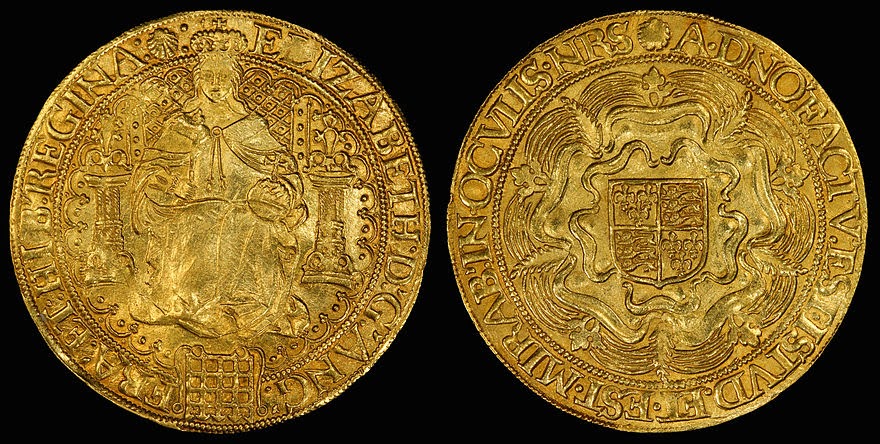
The sovereign gold coin was first issued in 1489 under King Henry VII of England. Its nominal value was one pound sterling or 20 shillings. The sovereign was primarily an official piece of bullion with no mark of value on its face.
The first sovereigns were 23-carat (95.83%) gold and weighed 240 grains (half a troy ounce). King Henry VIII reduced the gold content to 22 carats (91.67%), a move known as “The Great Debasement.”
The sovereign had a diameter of 42mm and weighed 15.55 grams. It is twice the weight of the existing gold coin, the ryal. The sovereign was mostly used as a presentation piece for dignitaries rather than everyday circulation.
The sovereign was temporarily replaced when King James I introduced the “unite” coin in 1604. It was reintroduced in 1817 and continues to be issued by the British Royal Mint to this day.
Did You Know?
This gold coin is named “sovereign” because of its large size and the royal portrait of the monarch on the obverse.
6. English Gold Angel
Launched: 1465 AD
Dynasty: English Kingdom
Years in Use: Approximately 177 years
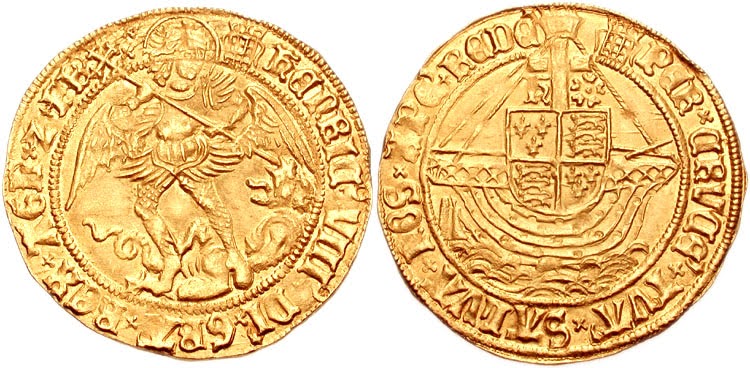
The English Gold Angel was introduced by King Edward IV in 1465. The pattern of the coin was inspired by the French Angelot or Ange coins, which had been issued since 1340. The value of the Angel coin differed over time, ranging from 6 shillings to 8 pence to 11 shillings.
The obverse side of the coin has Archangel Michael slaying a dragon, which gives the name “Angel.” The reverse has a ship with the rays of the sun at the top of the cross-shaped masthead.
The Angel was not minted during the Commonwealth under the Cromwells, as it was seen as “impious and idolatrous.” In 1660, Charles II began issuing gold-plated “touch pieces” instead of the Angel for the royal “healing” ceremony.
The Angel was last minted during the reign of Charles I in 1642, before the English Civil War.
Did You Know?
The Half Angel was introduced in 1472. It weighed 40 grains (2.6 grams) with a diameter of 20-21 mm.
5. English Gold Noble
Launched: 1344 AD
Dynasty: English Kingdom
Years in Use: Approximately 120 years
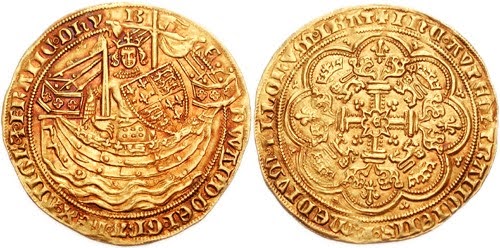
The English Gold Noble was introduced during the second coinage (1344-1346) of King Edward III. It was the first English gold coin produced in quantity before the gold penny and florin. The Noble had a value of 6 shillings and 8 pence, equivalent to one-third of a pound sterling.
The weight of the coin varied over time, from 138.5 grains (9.0 grams) to 120 grains (7.8 grams). The Noble had the king holding a sword and shield in a ship on the obverse and a cross on the reverse.
The inscriptions on the Noble changed during Edward III’s fourth coinage to show his claim on the French throne. Nobles were also produced under the reigns of Richard II, Henry IV, Henry V, and Henry VI.
The Noble remained a staple of the English monetary system for over a century until the first reign of Edward IV. In 1464, its value was increased to 8 shillings and 4 pence, and a new “Rose Noble” was introduced, though it was unpopular.
Did You Know?
Nobles minted at the Calais mint can be identified by the flag on the ship’s stern.
4. English Gold Florin
Launched: 1344 AD
Dynasty: English Kingdom
Years in Use: Approximately 2 years
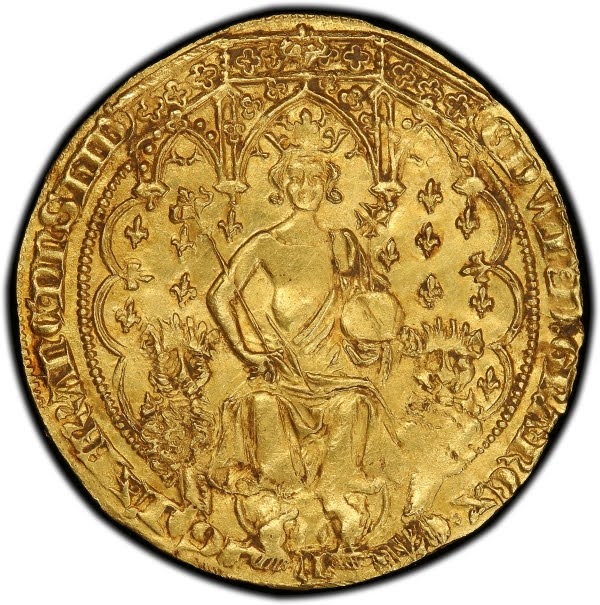
The English Gold Florin was introduced in 1344 during the reign of King Edward III. It was his attempt to produce a gold coinage suitable for use in Europe as well as England. The Florin was made from 108 grains (6.99829 grams) of pure gold and had a value of 6 shillings.
The obverse side has the design of the king enthroned. The reverse has a royal cross within a quatrefoil. The English Florin’s higher weight of 6.99829 grams was ultimately found to be wrongly valued. This made it unacceptable to merchants.
The Florin was withdrawn from circulation just a few months after its introduction and replaced by the more successful gold Noble.
Did You Know?
Only three examples of the English Florin are known to exist today. One surviving Florin was sold at auction in 2006 for a record £460,000 for a British coin. The English Florin has been included in lists of the world’s most expensive coins.
3. Roman Gold Solidus
Launched: 310 AD
Dynasty: Roman Empire
Years in Use: Approximately 11 years
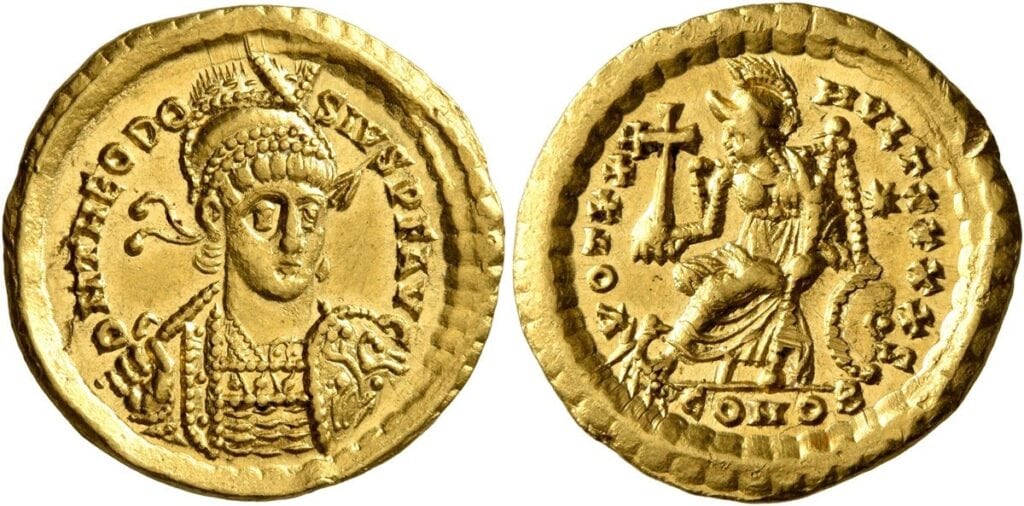
The solidus was a highly pure gold coin. It was introduced in the Later Roman Empire and Byzantine Empire in the early 4th century as a successor to the aureus coin. The solidus weighed around 4.5 grams, and its weight remained relatively constant for seven centuries.
In the Byzantine Empire, the solidus or nomisma remained highly pure until the 11th century. The solidus was the main gold coin of commerce in Western Europe from late Roman times to the 8th century.
It was initially introduced by Diocletian and later reintroduced for mass circulation by Constantine the Great. By the time of Constantine, the solidus was worth 275,000 increasingly debased denarii. The solidus inspired the Byzantine nomisma, the Kievan Rus’ zolotnik, and the Umayyad dinar.
Did You Know?
Solidus also functioned as a unit of weight equal to 1/72 of a Roman pound (approximately 4.5 grams).
2. Achaemenid Daric
Launched: Around 490 BC
Dynasty: Achaemenid Empire
Years in Use: Approximately 150 years
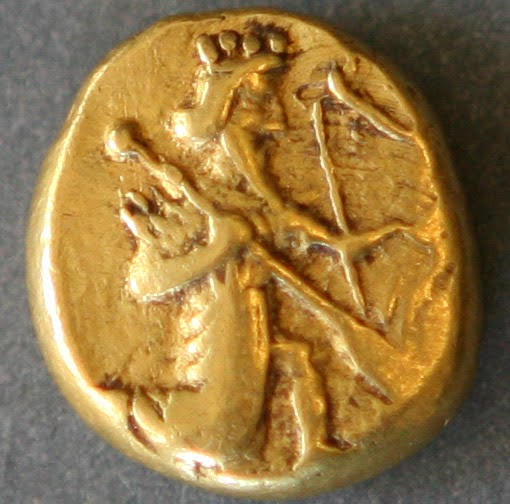
The Achaemenid Daric was a gold coin used in the Persian Empire around 490 BC. It was introduced by Cyrus the Great after he conquered the kingdom of Lydia. The Daric had a standard weight of 8.4 grams and was made of very pure gold, around 96% pure.
The coin had an image of the Persian king or a soldier with a bow and arrow. This showed the power of the Achaemenid rulers. Only the king had the authority to mint the Daric, and Darius I punished anyone else who tried to produce their own version.
After Alexander the Great conquered the Persian Empire, many Darics were melted down and made into new coins. Even after Alexander’s death, Darics continued to be minted in Babylon for some time.
Did You Know?
The Daric is mentioned in the Hebrew Bible, where it is called the “adarkonim.” The Greeks believed the name “Daric” came from Darius the Great, who may have introduced the coin.
1. Lydian Gold Coin (Croeseid)
Launched: Around 550 BC
Dynasty: Lydian Kingdom
Years in Use: Approximately 80 years
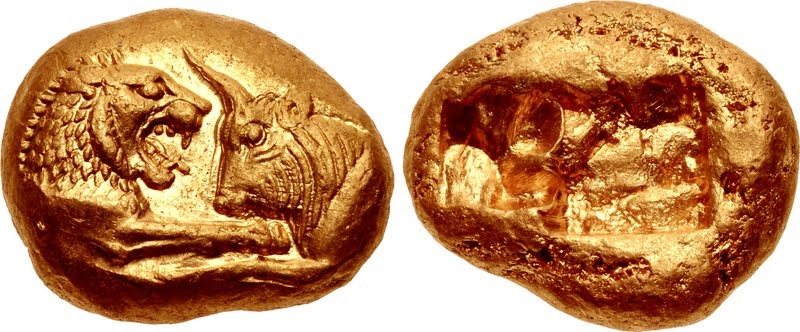
The Croeseid was minted in the city of Sardis, the capital of the ancient kingdom of Lydia. It is located in modern-day Turkey. There were both gold and silver coins. These coins were introduced around 550 BC during the reign of King Croesus. He is believed to be the first to issue standardized gold coins.
The Croeseid was part of the world’s first bimetallic monetary system. It had both gold and silver coins in circulation. The gold Croeseid coins initially weighed 10.7 grams, while the silver Croeseids also weighed 10.7 grams. There were also smaller denominations.
The design of the Croeseid had the foreparts of a lion and a bull facing each other. After some time, the weight of the gold Croeseid was reduced to 8.1 grams to simplify the exchange rate between gold and silver.
When the Persian king Cyrus the Great conquered Lydia, he adopted the Croeseid system. He continued minting similar coins at the Sardis mint. The Croeseid design and weight standard later influenced the development of the Achaemenid Persian coinage, including the famous gold Daric.
Did You Know?
The Croeseids had a clear and consistent intrinsic value guaranteed by their purity and weight, compared to the earlier electrum coins.
Conclusion
Gold coins remained a primary form of money until the early 20th century. Now, they are collectible items. The rare and historically significant ones are highly priced in the numismatics market.
However, the minting of large and commemorative coins started in 2007, with the Royal Canadian Mint producing a 100-kilogram gold coin. Gold coins have evolved a lot over the ages. But the value of Gold as a metal kept on increasing. Gold is a highly valued symbol of power in any age and time.






